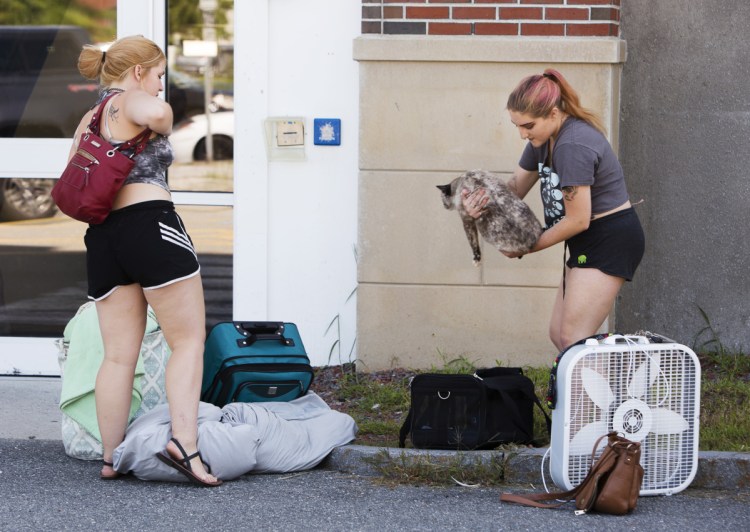SOUTH PORTLAND — About 60 Southern Maine Community College students living at Spring Point Residence Hall moved to temporary quarters Sunday after being told Saturday night they had less than 24 hours to vacate the dorm because of widespread mold in the building.
The college attributed the problem to a malfunction in the dorm’s heating, ventilation and air conditioning system.
Tests to determine if the mold poses a health hazard were conducted Sunday as college officials scrambled to come up with alternative housing arrangements – should the tests show the building is unsafe – for another 260 students due to move into the dorm on Friday.
Results should be available by Monday, said SMCC President Joseph Cassidy.
Three students living at the dorm complained of physical reactions after the administration told them of the problem, Cassidy said.
Students were informed they would have to move out of the dorm in letters placed under the doors of their rooms Saturday night, said Olivia Treadwell, a sophomore who was living at the Spring Point dorm.
On Sunday morning, students, who began moving into Spring Point for the upcoming semester two weeks ago, were rushing to meet the noon deadline to move their belongings to Surfsite Residence Hall, the college’s only other dorm, where they will be temporarily housed.
Some were angry and upset that it had taken the administration so long to address the mold problem. Dark, moldy areas were clearly visible Sunday on the ceiling tiles and on furniture inside the four-story, 10-year-old building.
Treadwell said the mold was obvious when she moved in two weeks ago. She is planning a protest for 6 p.m. Monday on the seaside campus.

Mold grows on the ceiling in a hallway in Spring Point Residence Hall at SMCC. Dozens of students living in the hall were moved to other housing on Sunday.
“We want transparency,” said Treadwell.
She said the college should also reimburse students who incurred medical or other expenses because of the mold and the move.
Treadwell said it was her Facebook posts that included photographs of the mold that got the administration to act. Cassidy said that was not the case.
Cassidy, who started as president of SMCC at the beginning of August, said that as far as he knows, the administration did not learn about the mold until Friday night.
“We will certainly be investigating to see if there was any missed opportunity to deal with it earlier,” he said.
He said there had been an ongoing problem with moisture in the ceilings but this was the first time mold had been detected.
Other students said they were more irritated than angry.
“It is annoying. They haven’t said anything,” said Jamal Durrani of Lebanon, a criminal justice major who had arrived two days earlier for soccer practice.
Dean of Students Tiffanie Bentley said in Saturday’s letter to dorm residents that the mold had been caused by a mechanical malfunction in the building’s HVAC system.
“The combination of the higher than usual temperatures and humidity outside in conjunction with the mechanical malfunction has created an indoor humidity level that has led to mold growth in the building,” she wrote.
Repairs to the HVAC system began Sunday, and students were told they would not have access to the Spring Point rooms during the repair period.
“So you must bring everything with you that you will need for the next few days,” Bentley said in her letter.
Cassidy said the college would share the mold test results with the students as soon as they become available.
Indoor exposure to mold has been linked to upper respiratory tract symptoms, such as coughing and wheezing, and stuffy nose, and red or itchy eyes or skin in healthy people, and can exacerbate symptoms in people with asthma, according to the U.S. Centers for Disease Control and Prevention. Some people, such as those with allergies to molds or with asthma, may have more intense reactions, such as fever and shortness of breath.
On Sunday, the displaced students piled their things into laundry baskets and cars for the move up the hill to Surfsite, which has room for 147 students. Some students, who are allowed to have cats, moved their feline companions with them.
College officials scheduled a meeting with students Sunday night that was closed to the public. Clarke Canfield, the college’s spokesman, said one student attended.
Cassidy said the health of the students is the administration’s priority. He said the college would help students affected by the problem.
“We will do right by them. We will remediate if necessary,” he said.
He said the staff is coming up with a plan should the students not be allowed back at Spring Point. He said it may include housing students at hotels or looking for rooms at other area colleges.
On Sunday it was unclear whether the mold at Spring Point could be cleaned up in time for Friday, the college move-in day. The fall semester officially begins Aug. 27.
Mold can be removed from hard surfaces by cleaning with commercial products, soap and water, or a bleach solution. Absorbent or porous materials like ceiling tiles, drywall and carpet usually have to be thrown away, according to the CDC.
College officials said they are waiting for the test results before deciding what to do next.
“It would be premature to say what the next step will be until we can make a determination” about the scope of the problem, Canfield said.
Staff Writer Dennis Hoey contributed to this report.
Send questions/comments to the editors.




Comments are no longer available on this story